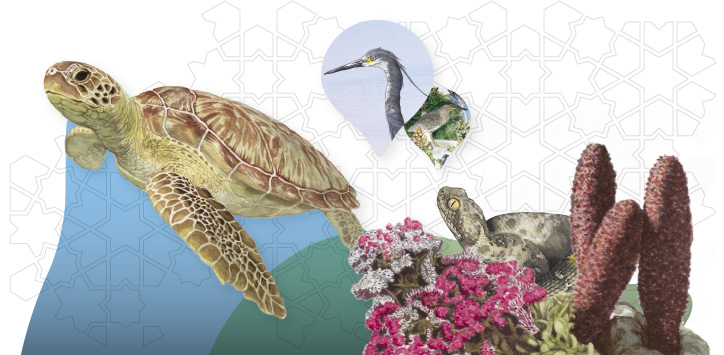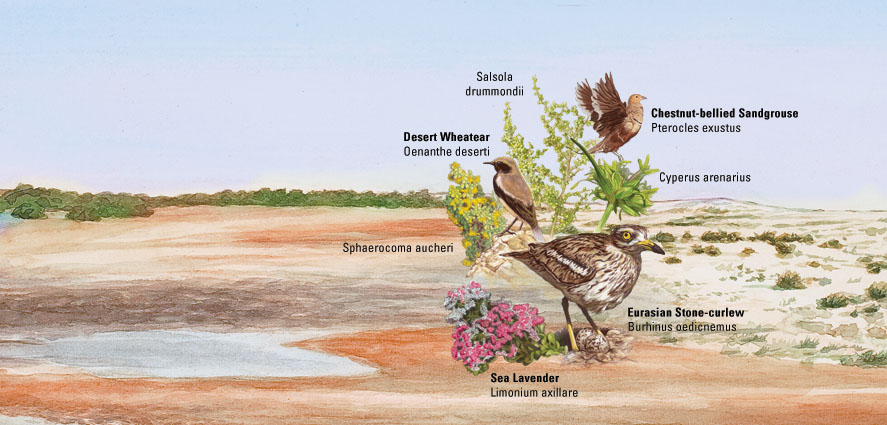
You are in :
Coastal Habitats

Coastal Habitats
The coastal habitats of Abu Dhabi are diverse, comprising of mangrove forests, salt marshes, tidal flats with cyanobacterial (algal) mats, sandy and rocky beaches, coastal flats with low dunes, sabkhas, cliffs and rocky headlands. The coastal vegetation of the region is likewise diverse, specialised and extremely productive, notwithstanding often harsh growing conditions. Vegetation types include halophytic (salt tolerant) Dwarf Shrubs of the Goosefoot family (Chenopodiaceae) and Caltrop family (Zygophyllaceae). The parasitic plants Red Thumb (Cynomorium coccineum) and Desert Hyacinth (Cistanche tubulosa) are common in coastal areas in association with the chenopods. Salt-tolerant grasses can also be found. Mangroves are well-developed along parts of the coastline and serve many valuable ecosystem functions. Cyanobacterial mats are widespread along the more extensive and sheltered areas of the coastline. Higher order plants are able to colonise these mats when a thin covering of blown sand accumulates on the surface providing the invading plants with a growing medium and anchor for their roots. Cemented sand dunes form rocky outcrops in scattered localities along the coastline in the more western parts of the Emirate. Halophytic and non-halophytic annual plants occur on these rocky outcrops, sometimes occupying the most precarious and unlikely of locations.
The Coastal Sabkha

Sabkha (meaning salt flat) is an Arabic term describing the often remarkably flat and salt-encrusted desert that is usually devoid of significant plant cover or indeed any obvious signs of life. The Emirate's sabkha extends over hundreds of kilometres along the coast and is a unique feature of the inland landscape. High concentrations of salts (mainly calcium carbonate, gypsum, anhydrite and sodium chloride) on the sabkha surface prevent the growth of most plant species, and as a consequence, landscapes dominated by sabkha appear distinctly barren. Plant life is usually restricted to the margins of the sabkha with Halophytes (chenopods) dominating these marginal niches. Some plants are able to germinate on the sabkha surface after heavy rainfall, since this leads to a temporary reduction in salt concentrations. Although appearing lifeless, upon closer examination sabkhas can support limited plant communities, which, through resilience and adaptation, have come to populate this most extreme of environments. The cracked crusty surface provides a remarkable shaded micro-habitat exploited by several insect species in an otherwise barren landscape.
Marine Turtle Nesting

The most common species of marine turtle in Abu Dhabi's waters are Hawksbill (Eretmochelys imbricata) and Green (Chelonia mydas). These two species extensively use the warm waters for foraging and the hawksbill hauls itself up on sandy beaches to nest close to sheltering vegetation.
What's Special About Halophytes?

Only around 2% of all plant species are halophytes. These plants are specially adapted to salty environments. Adaptations may take the form of salt tolerance (capable of absorbing and storing saline water) or salt avoidance (by timing reproduction when salt concentrations in the environment are low). Some halophytes are succulents; they are capable of storing large amounts of water in their leaves – another adaptation that allows them to persist during periods of drought.
White Sand Dunes – Floral Communities-in-Waiting

Coastal white sands are derived almost exclusively from the remnants of marine organisms and carbonate sediments. An important characteristic of coastal white sands is the virtual lack of any direct influence of salt, despite their proximity to the coast. Therefore, the vegetation is characterised almost exclusively by glycophytes (plants adversely affected by salts). Heavy rain at the onset of the cooler winter period followed by occasional showers provides favourable conditions for the flowering of desert annuals, with the populations of these plants greatly reduced in drier years.
Plant Root Detail

Coastal white sands are generally favourable for plant growth in arid regions because of the capacity of the coarse sand to store water, often for substantial periods. When it does rain on the dunes, water percolates the upper sand layers rapidly and is not lost through surface run-off. As the upper regions of sand tend to dry out rather quickly, substantial water is stored in the subsurface sand layers where it is protected from evaporation. Consequently, even plants with rather shallow roots are able to tap into this periodic water. Once these plant colonies have established themselves, they serve to stabilise the dunes.
Plant Communities and Contrasting Diversity

Soil salinity, its capacity to hold water and the frequency of tidal inundation have a great influence on plant distribution and diversity in the coastal zone.
Salt-tolerant chenopods such as Arthrocnemum (Arthrocnemum macrostachyum), Halocnemum (Halocnemum strobilaceum) and Salsola (Salsola drummondii) are predominant near the shoreline as are mat-forming grasses and dwarf shrubs such as Sea Lavender (Limonium axillare). Halophytes like Sphaerocoma (Sphaerocoma aucheri) and Cornulaca (Cornulaca monacantha) colonise the coastal dunes while salt-tolerant succulents like Seidlitzia, (Seidlitzia rosmarinus) and Zygophyllum (Tetraena qatarense) occupy the sand sheets. Commonly known as the 'string of beads', Halopeplis (Halopeplis perfoliata) is the most tolerant of all the halophytes and is the dominant species in sabkha.
Rock Cliffs

Precarious Habitat for Plants and Nesting Birds
Medium-sized cliffs relieve the monotony of the coastal landscape and are a characteristic feature along the southern Gulf coast. Depending on the influence of salt-laden dust, these exposures are colonised by a mix of halophytic and non halophytic species. Plant species include Cornulaca (Cornulaca monacantha), Helianthemum (Helianthemum lippi), Panicum (Panicum turgidum) and Salsola (Salsola drummondii). The rock cliffs are excellent habitat for Sooty Falcons (Falco concolor), a medium-sized bird of prey that is one of the most endangered bird species in the Emirate.

















